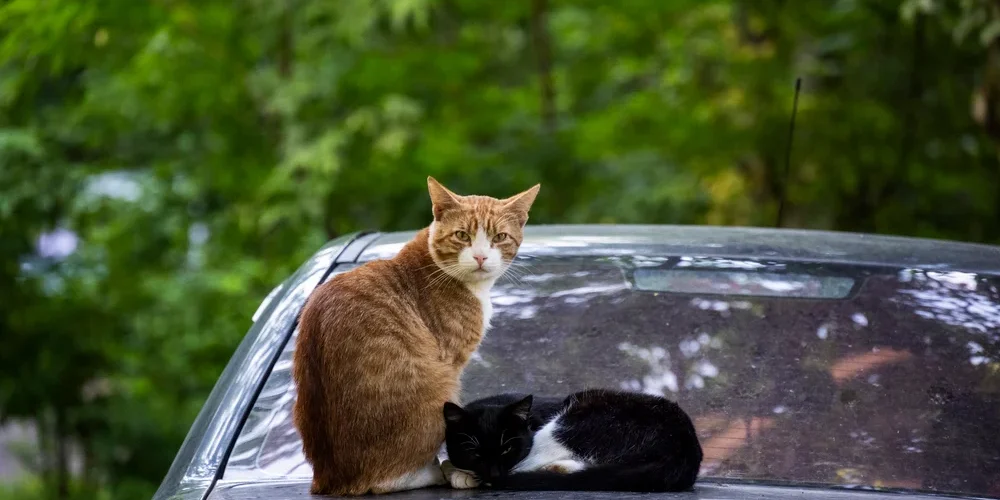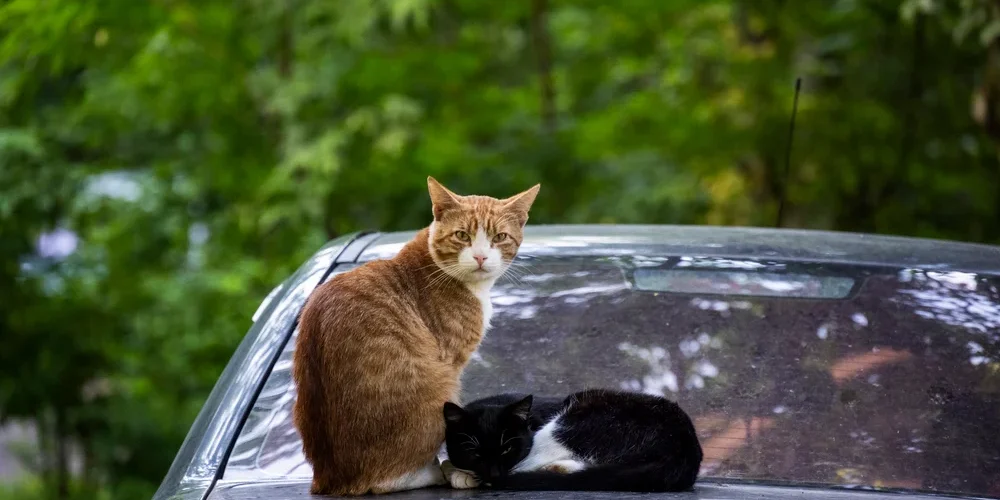how to keep cats off your car


Introduction
When cats climb onto parked cars, they can leave scratches, paw prints and even dents. To prevent this damage, it is important to find ways to keep cats off your car. While there are many methods online, not all of them are effective or safe for the cat. Here are some solutions that have been proven to deter our feline friends from using our cars as their personal playground.
One method is to use a repellent spray, specifically designed for cats, on and around the car’s exterior. Another solution is laying down aluminum foil or double-sided tape on the car’s hood or roof as cats dislike these materials’ texture and sound. For homeowners with a garage, keeping the car inside will diminish any interest a curious cat might have in exploring its surface. Nonetheless, If you don’t own a garage or parking lot, consider using a cover for your vehicle.
While we love our feline companions as pets, their curiosity can lead them into trouble sometimes. Such as when they step foot on an unfamiliar car. This is precisely what happened two years ago to my neighbor’s brand-new blue Honda Civic that was parked close by the curbside late evening. To his astonishment in the next morning sunlit glimpse he noticed several new scratches all over his vehicle’s hood and roof! Take steps to protect your vehicle lest you find yourself patching up costly bodywork damage inflicted by those adorable four-legged furry creatures roaming around at nightfall!
Why do cats climb on cars? So they can get a better view of the world they’re slowly taking over.
Why Do Cats Climb on Cars?
Cats are naturally curious, territorial, and agile creatures. They climb on cars for warmth, safety, and to mark their territory. By observing other cats climb on the same car, they may also follow suit. Additionally, cars offer a raised platform that provides a better vantage point to survey their surroundings. As cats are known to scratch and claw, the hood or roof of a car may also attract them.
To deter cats from climbing on cars, various solutions include:
- covering the car with a protective sheet
- placing obstacles around the car
- using special scents or sprays
- keeping the garage door closed or making use of a car cover
However, it is important to avoid using harmful chemicals or methods that may harm the cat or cause damage to the car.
Interestingly, some cultures view cats sitting on cars as a sign of good luck or prosperity. In Japan, it is believed that a cat sitting on the hood of one’s car can bring good fortune and protection from accidents. Therefore, some car owners may not mind when cats climb on their vehicles.
A friend once shared a story of how her neighbor’s cat would always climb on her car and leave scratches and paw prints on the hood. After trying several solutions, she resorted to placing a toy cat on her car which seemed to deter the real cat from climbing on it. While not a foolproof solution, it provided her with some relief from the cat’s unwelcome visits.
Understanding cats is like trying to solve a Rubik’s cube – just when you think you’ve got it figured out, they scramble your perception again.
Understanding Feline Behavior
Cats are notorious for climbing on cars. This behavior is not random, but rather an instinctive action resulting from their territorial nature. As creatures of habit, felines choose a specific spot to call home and will defend it fiercely. When they perceive a car parked in their territory, they may climb on it to leave their scent as a warning to other cats that this area belongs to them.
Moreover, cats also climb on cars because they have excellent climbing abilities and enjoy finding new high vantage points from which to survey their surroundings. This provides them with both mental stimulation and physical exercise, keeping them happy and healthy.
Interestingly, the color of the car can also be a factor in attracting feline climbers. Cats are more likely to climb on cars with darker colors as they provide better camouflage for the cat’s fur.
Pro Tip: To prevent your car from becoming a cat’s personal playground or scratching post, try covering your vehicle with a tarpaulin or using a car cover when parked outside. This will help discourage unwanted visitors while protecting your investment from scratches and other damage caused by paws or claws.
Looks like cats are just as curious about car models as humans are.
Reasons for Car Climbing
Cats have various reasons for climbing on vehicles, such as marking territory, seeking warmth or a vantage point to observe prey. They also enjoy the smooth surface of cars to scratch and sharpen their claws. Additionally, cats may view a car as an obstacle to cross over as they climb from one place to another.
Interestingly, according to a report by Allstate Insurance Company, cats on cars contribute to more than 2 million insurance claims per year in the US alone.
Why pay for a car wash when your neighborhood cat can provide a free paw print detailing service?
Solutions to Keep Cats Off Your Car
As a car owner, it can be frustrating to have cats lounging on your car, leaving paw prints and scratches. Here are some effective ways to prevent this:
- Cover the car with a car cover: This will make it less appealing for cats as they will not be able to climb on the car or leave any marks.
- Use deterrent spray: There are strong-smelling sprays available in the market that cats dislike. Spray it around the car and on the tires to keep them away.
- Install motion-activated sprinklers: These sprinklers detect any movement and spray a burst of water, which is effective in deterring cats.
- Use ultrasonic devices: These devices emit a high-frequency sound that is unpleasant for cats. Place them around the car to keep cats away.
It is important to note that these solutions may not work for all cats, and it may take a few tries to find the most effective one for your situation. Additionally, it is important to check for any local regulations regarding the use of sprays or devices.
Pro Tip: Regularly cleaning and washing your car can also discourage cats from lounging on it, as they prefer clean and dry surfaces.
Avoid the hassle of cleaning up cat paw prints with a simple spray that’ll make your car less appealing than a litter box.
Use of Repellent Sprays
Cat Repellent Sprays – A Professional Solution to Keep Felines Away from Your Vehicle
Cat repellent sprays are a reliable way to dissuade cats from approaching and jumping onto your car. Listed below are some points to understand how repellent sprays work:
- Cat repellent sprays create an odor that buries the smell of the surface you spray it on, thus making it unappealing for cats.
- The unpleasant smell generated by these sprays triggers a natural instinct in cats to avoid specific areas, including your vehicle.
- Cat repellent sprays are safe to use since most cat deterrent products use natural essential oils and extracts, such as mint and citronella oil.
- Some cat deterrent sprays also have high sound frequency ultrasonic alarms that scare away feline intruders effectively.
It is worth mentioning that some repellents may not be compatible with specific surfaces or finishes. Always read the product label before use.
Unique Details
To ensure maximum effectiveness and longevity of the cat repellent spray, do not hose or wash the treated area for at least 24 hours after application. The solution can lose its scent intensity if exposed to strong weather conditions like heavy rain or wind.
Suggestions
Here are some tips you can follow when using cat repellent sprays:
- Choose a product tailored specifically for deterring cats and approved by relevant authorities.
- Clean the surface of your vehicle thoroughly before applying any spray to optimize its adherence and effectiveness.
- Spray around all corners of the car where cats tend to climb up: wheels, bumpers, windshield etc.
- If using an ultrasonic alarm-type spray, always check if it’s audible at a considerable distance from your neighborhood houses.
Who needs a car cover when you can just wrap your ride in the wildest cat-print fabric you can find?
Creative Use of Coverings
| Cover | Material | Effectiveness |
|---|---|---|
| Stickers | Adhesive Vinyl | Medium |
| Tinfoil | Aluminium foil | High |
| Bubble Wrap | Plastic Bagging Material | Medium |
| Netting | Synthetic fiber | High |
| Cardboard | Corrugated recycled paper material | Low |
For more aesthetically pleasing options, utilize decorative covers such as burlap or fitted car covers. Additionally, motion-activated sprinklers or ultrasound devices have also been used to deter cats from getting too close to parked cars.
According to AA Insurance Services (New Zealand), vehicle owners claim around NZD$1 million per year due to cat-related damage.
Motion-sensor devices: the only way to keep both your car and your cat on their toes.
Use of Motion-Sensor Devices
There are various techniques that can be employed to discourage cats from jumping on your car. One effective strategy is the application of motion-sensitive devices. These gadgets are designed to detect movements and emit a loud sound or flashing light, causing cats to flee the area.
Motion-sensor devices can come in the form of sprinklers, alarms or ultrasonic machines. While sprinklers work by spraying water when activated, alarms produce sharp sounds upon detecting movement. Ultrasonic devices emit high-frequency sounds that are unpleasant for felines to hear, thus deterring them from approaching your vehicle.
Apart from keeping cats at bay, motion-sensitive devices serve as low-cost deterrent solutions that require little maintenance. However, it is important to place them strategically around your vehicle and test their efficiency before leaving your car overnight in an open area.
Ensure that the noise level of these gadgets is not too loud as it may disturb the peace within residential areas. The aim here is not to cause friction with neighbours but to maintain a clean car surface free from cat scratches and litter.
Hence, several drivers who have installed motion-sensitive machines claim positive outcomes in preventing feline intrusions onto their cars. By using these gadgets correctly, you too can safeguard your ride and avoid costly cleaning expenses down the road.
Don’t encourage cats to stay away from your car, encourage them to start their own car detailing business.
Encouraging Cats to Stay Away
Cats are often attracted to parked cars, which can lead to scratches and other damage. To discourage cats from getting too close to your car, there are several effective strategies you can try.
One strategy for keeping cats off your car is to make the area less attractive to them. This can be done by cleaning up any spilled food or water and removing any outdoor litter boxes in the vicinity. Additionally, you can try using motion-activated sprinklers or ultrasonic repellers to deter felines from coming too close.
Here are five steps that can help keep cats away from your vehicle:
- Use a car cover: Covering your car with a protective cover is an effective way to prevent cats from scratching your paintwork or leaving paw prints on the hood.
- Plant cat-repelling herbs: Certain plants such as lavender, citronella, and rue are known to be unappealing to cats and may help keep them away.
- Use citrus scents: Cats generally dislike the smell of citrus fruits such as oranges and lemons. You can use slices of these fruits around your car or try spraying a citrus-scented repellent.
- Try noise deterrents: Cats hate loud noises, so investing in noise-making devices such as alarms or clapping machines may deter them from climbing onto your vehicle.
- Install physical barriers: Installing chicken wire or strips of double-sided tape around your vehicle may make it harder for cats to climb onto it.
Lastly, it is important to note that some methods may work better than others depending on the individual behavior of local cats in your area.
Interestingly enough, Egyptians worshipped cats as sacred animals in ancient times due to their perceived divinity. They believed killing a cat was punishable by death and would often mummify their deceased pets as they would with humans.
Lock your cat inside with a bowl of milk and a mouse toy, and your car will be safe…until the apocalypse hits, that is.
Preventing Future Occurrences
Preventing Recurrence: Efficient Strategies to Keep Cats Off Your Vehicle
It is essential to implement effective techniques to prevent cats from jumping and settling on your car. Firstly, install motion-activated sprinklers around your parked vehicle to startle the feline intruders. Secondly, create an obstacle course using empty cans and aluminum foils at the hood, windshield, and side mirrors of your car to deter their approach. As a result, cats will avoid the sensation and sound created by the crinkly textures of the foils and cans. Thirdly, apply cat-repellent sprays on your car’s surface to keep them off. These sprays are non-toxic to cats and protect your car’s exterior from scratches.
To complement these strategies, it is recommended to park your car in an enclosed garage or a car shelter, primarily when cats tend to roam frequently. Additionally, always keep your surroundings clean, including food and water sources for your pets and strays, to prevent cats from being attracted to your property.
Pro Tip: Regular maintenance of the above prevention techniques ensures cats won’t return and protect your car’s surface.
Regular car maintenance may keep your vehicle running smoothly, but it won’t stop your neighbor’s cat from using it as a scratching post.
Regular Car Maintenance
Here’s a 5-Step Guide to maintain your car:
- Check tire pressure regularly.
- Change engine oil and filter every 3 months or 3000 miles.
- Replace air filters every 12 months or after driving 12000 miles.
- Regularly check brakes and brake fluid level.
- Wash your car at least once a week to prevent exterior damage.
Additionally, regularly checking and replacing fluids such as transmission fluid, coolant, and power steering fluid can prolong the life of your car. It’s also important to follow the manufacturer’s recommended maintenance schedule.
Pro Tip: Don’t forget to check your owner’s manual for specific care instructions unique to your make and model.
Why bother neutering or spaying cats when we can just adopt them out to crazy cat ladies who will keep them all and prevent any future feline reproductions?
Neutering or Spaying Cats
As a responsible pet owner, it is crucial to ensure the reproductive health of your furry friend. One way to do so is by performing a surgical procedure known as ‘Feline Sterilization.’ This process refers to neutering or spaying your cat.
- Neutering refers to the removal of the testicles in male cats, which helps minimize aggressive behavior and reduces the risk of prostate cancer.
- Spaying is the removal of a female cat’s ovaries and uterus, which not only prevents unwanted pregnancies but also reduces the risk of breast tumors and uterine infections.
- Both procedures are performed under general anesthesia by a skilled veterinarian in their clinic.
- Cats can be sterilized as early as 2-3 months old, and it is generally a safe process with minimal complications.
It is worth noting that some myths surrounding these procedures claim that they can alter a cat’s personality or lead them to become lazy. Still, scientific evidence suggests otherwise.
To prevent future occurrences, consider neutering or spaying your feline companion. This way, you will eliminate the concern for unwanted litters and reduce the risks associated with various reproductive-related diseases.
If you have not yet done so, schedule an appointment with a trusted veterinarian today. Do not miss out on securing your cat’s lifelong well-being!
Remember, when talking to neighbors about their pets, it’s important to maintain a friendly tone, even when you’re secretly plotting to steal their adorable puppy.
Talking to Neighbors About Their Pets
Effective Communication with Pet Owners in the Neighborhood
Building a good relationship with your neighbors can be challenging, particularly when it comes to discussing their pets. However, it is crucial to communicate with pet owners timely and effectively to ensure their furry friends do not become a nuisance to others in the neighborhood.
When facing this situation, initiate a friendly conversation with the pet owner, mentioning your concerns without accusing them of any wrongdoing. Suggest ways that might help alleviate the problems caused by their pets and show empathy towards their concerns as well. Understanding the situation from both sides will enable you to handle it more efficiently.
It is essential always to keep calm and approach every discussion with respect and understanding. Additionally, one tip for making communication more effective is sharing personal experiences related to pets in a similar way.
Pro Tip: By offering pet owners within your neighborhood effective communication channels like local social media groups, it becomes much easier and efficient to discuss such issues regularly.
Remember, the best way to prevent future occurrences is to learn from past mistakes and hope no one is watching when you make new ones.
Conclusion
Starting with the resolution to discourage feline intrusions, various legitimate methods can be implemented. A few effective techniques include physical barriers such as covering your car or applying deterrent sprays.
To further prevent these unwanted guests, maintaining a clean environment and reducing food sources are two highly recommended actions to take. Consistency in enforcing these measures is key to ensuring cats stay off your car.
One unique tip involves using natural scents such as citrus or eucalyptus to deter cats from approaching the vehicle. Additionally, motion-activated devices that emit loud noises or air sprays can also be employed for successful control.
Interestingly, ancient Egyptian tombs offered one of the first historical records of humans keeping cats as pets and for pest control. This demonstrates how long we’ve shared spaces with our feline friends, making it all the more important to establish boundaries when needed.
Frequently Asked Questions
Q: How do I keep cats off my car?
A: There are several methods you can try, including using a car cover, installing motion-activated deterrents, or placing aluminum foil or double-sided tape on your car.
Q: Are there any specific scents that deter cats from cars?
A: Cats are repelled by strong scents such as citrus, eucalyptus, or lavender. You can try spraying your car with a homemade mixture of one or more of these scents diluted in water.
Q: Can I use plants to keep cats off my car?
A: Yes! Some plants such as lavender, Coleus canina, prickly pear cactus, and rue have been known to repel cats. However, make sure to keep them away from your car’s paint as they may cause damage.
Q: Will putting a bowl of water on my car discourage cats?
A: No, cats actually like water and may be attracted to the bowl, which can cause further damage to your car.
Q: Why do cats sit on cars?
A: Cats often sit on cars because it provides a vantage point for them to observe their surroundings. Additionally, the warmth from the engine can also be attractive to them.
Q: Can I use a car cover to keep cats off my car?
A: Yes! A car cover can be an effective way to keep cats off your car, as it creates a physical barrier that they can’t climb on. However, make sure to regularly check and clean the cover to prevent any damage to your car’s paint.











[…] to get your parents to cooperate with your car leasing plans is like trying to teach a cat to fetch, it’s not impossible, but it sure feels like […]